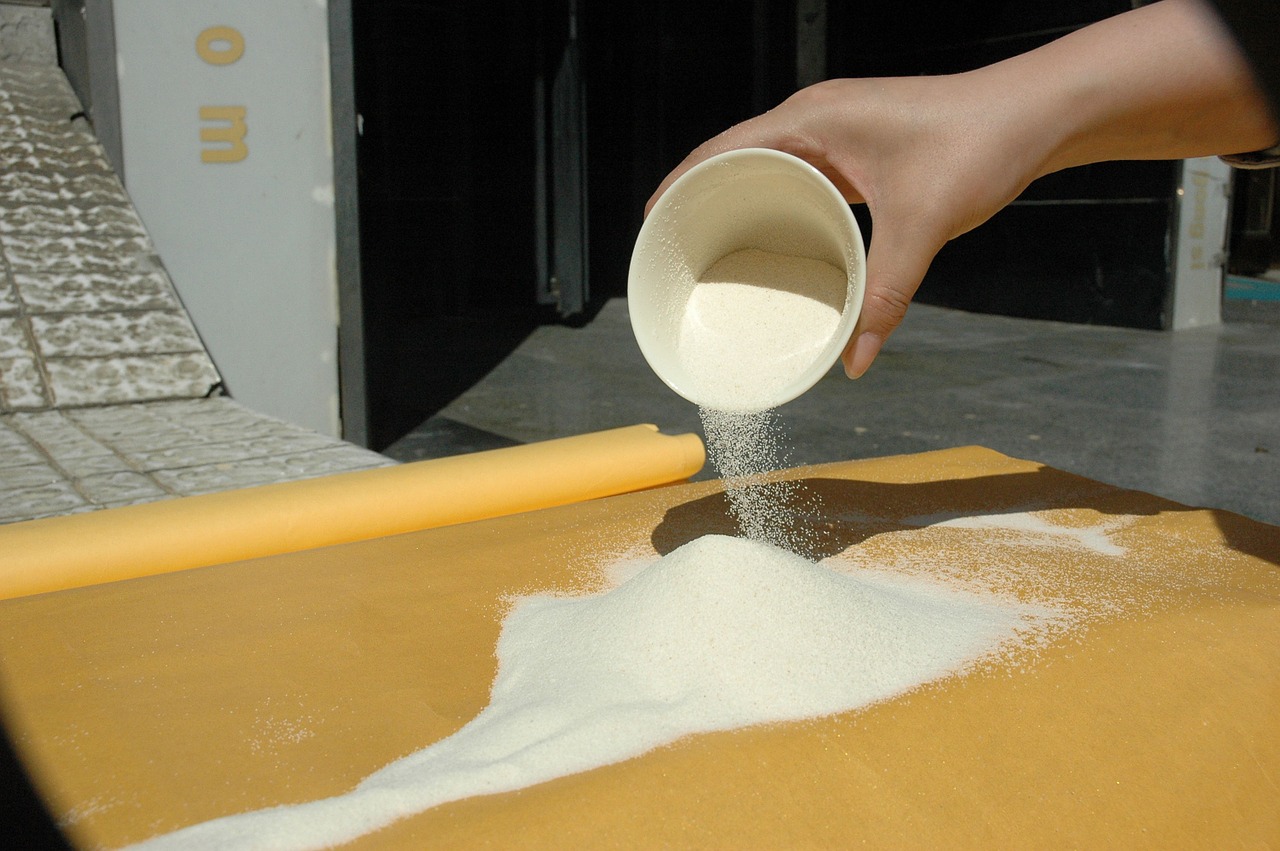Suji and Rava are the popular Indian names of granulated wheat flour that have a grainy and coarse texture to them. Another name for this popular Indian granulated wheat flour is semolina. Semolina is the name that is more popular than Suji or Rava as it is used internationally while the latter two names are used in India and Pakistan. Suji or rava are used to prepare popular South Indian recipes like upma, rava dosa, vada, and many sweets or desserts like halwa, barfi, etc. All you need is sugar, milk, suji or rava, etc. to make these sweets.
Suji is the common name used for the coarsely granulated wheat flower in most parts of northern India and Pakistan, and the name Rava is used by people in the southern parts of India. Suji and Rava do not have any major differences when it comes to the component they are made of. They both are made from wheat and are very similar when it comes to the appearance. Suji rava are words that are used simultaneously, which generally leave people confused.
They are only different names of the same flour, and they are addressed by different names based on different geographies. They may vary in size in a very minute way as Rava granules are slightly bigger than the Suji granules. Other than these minute and negligible differences they are one and the same flour, that is, they are the two sides of the same coin. They are both the same flour used for making a variety of food items like sweets or dessert, savories, and other main course dishes throughout the world.
Quick Recipes with Rava/Suji: Call it Suji or Rava as you want but don’t forget to try these dishes.
Table of Contents
Uses of Suji and Rava
Suji flour and Rava flour are used for making a variety of foods in and around the world. Semolina is the Italian name for Suji and Rava. This flour can be prepared into a batter form to make most Indian sweets or dessert and savories and is also enjoyed in South India more than anywhere else. If they are made into batter they should be finely ground so that the granules don’t taste weird and chewy once the batter is cooked. If they are used as ingredients in main course dishes they are used in their natural coarse form for an authentic taste and texture.
Suji and Rava or semolina are used to make many Indian dishes and varieties of food. A few of the many main Indian sweet and savory recipes prepared out of suji or Rava are rava bread, upma, rava dosa, rava laddoo and halwa. Upma is an South Indian savory dish while the other two are sweets. Suji or Rava upma recipe is usually prepared as a breakfast throughout India and Pakistan. They are cooked like porridge and are delicious to eat with proper side dishes. Dosas are generally made with rice, but it can be made with suji or rava.
Tata Himalayan Rock Pink Salt, 1kg Pouch, Premium Sendha Namak, With Natural Trace Minerals, Low Sodium, Crystal Salt
₹104.00 (as of November 22, 2024 16:56 GMT +05:30 - More infoProduct prices and availability are accurate as of the date/time indicated and are subject to change. Any price and availability information displayed on [relevant Amazon Site(s), as applicable] at the time of purchase will apply to the purchase of this product.)Suji and Rava, also known as semolina, which is granulated wheat flour, are used by many people worldwide to make other dishes as well. They are not exclusively cooked only in India and Pakistan. However, they are known to many people around the world by a different name called semolina. They are mostly used by pizzerias as a base coarse powder texture to help in the transferring of pizza from the pizza sheet to the oven without the pizza dough base sticking to the pizza sheet/ pan.
Suji or rava, which are granulated wheat flour, are also used to make different and many popular varieties of sweet cakes like plain vanilla cake, lemon cake, orange cake, yogurt cake, etc. Other than cakes and other savory and sweet dishes discussed above, semolina is also used to make cookies, pancakes, dumplings, and puddings. They are also used as pizza crusts as they are very easy to make and will make the pizza unique and tasty.
Related Reading:
Confused about which brand to buy? Here we listed a few best brands of suji to buy.
Suji and Rava as baby foods
Rava or Suji, also known as semolina, are not only great foods also used for adults, but they are so healthy that they are a great source of food for babies as well. The high nutritional value of Rava makes it good for babies. It is easy to chew for the babies when cooked well. They are usually given as well-cooked porridge to babies along with fruits, vegetables, and lentils. It is a great combination that goes with fruits, vegetables, and lentils.
Suji and Rava or semolina are also made into a slurry and are infused into stews, gravies, and soups to thicken them. They are very delicious to taste as they are a very versatile ingredient that can be also used for a variety of purposes because of their granulated wheat like texture. If you love cooking, suji or rava will be a great ingredient for you.
Health Benefits of Rava (Suji)
Semolina, also known as Rava or suji – call it by whatever form or name you want, but they come with impressive health benefits that don’t change with the name. Did you know that the Rava or suji that you use in your everyday dishes comes with these impressive health benefits?
- Semolina, which is nothing but granulated whole wheat flour is also used to keep you full for a long time, thereby keeping your hunger pangs at bay.
- Contains essential minerals such as zinc, phosphorus and magnesium to promote your bone health and keep you energized all through the day.
- Contains selenium in large quantities, which is great for your overall cardiovascular health.
- Semolina, also known as rava or suji, is a rich source of iron; therefore, reduces your risk to anemia and dehydration.
- Suji tends to raise in water. It is quite a filling food and keeps you full for long.

Other varieties of Suji/ Rava
There are also other varieties of suji and Rava or semolina that isn’t just made from normal wheat. One of them called Bansi Rava and also known as samba wheat in many parts of India. They are slightly fine powdered flour unlike the coarsely granulated suji and Rava or semolina. They are made from slightly elongated wheat grains. Suji is a great flour for replacing other ingredients like maida, and it is a much healthier ingredient , especially for our body.
Another famously known Rava is the special Bombay Rava in India, which has a very coarse texture as compared to that of the fine texture of Bansi Rava, more like powder form. This flour is made from whole wheat grains and is a little bigger than the regular Rava or suji, and is popular found in India. Bansi rava has its origin in South India. Bansi rava is said to be an all-season flour. You can make savory items like bhatura, dhokla, kheer or upma with bansi rava. There is something known as samba rava, which is not very popular but another version of rava.
FAQs
1. What is sooji or suji called in English?
Suji or sooji is known as semolina in English.
2. Does suji gain weight? Is suji fattening?
Suji is quite healthy as it is made of whole wheat, and is less processed than most grains. Suji can help you lose weight if you add more protein and fiber into it. So if you are making upma, you can add a lot of vegetables to add nutrition to it. Please ensure eating suji in moderation. Many people could be allergic to it as it has gluten in it.
3. What are some healthy ways I can eat suji or sooji?
You can prepare upma, suji cheela, suji/rava dosa, suji idli, etc. using suji/rava. These are not just delicious but also make for a healthy snack!
Suji Vs Rava: The Conclusion
Whatever be the name of the flour, they all are also made from the same original product (wheat) and are popularly consumed in India. Hence, both will taste the same and won’t have any major difference other than the separate names given to them in various parts of the world. Only the texture of the flour has a slight variation, but they are also used to make the same foods in the same manner without having to do any major alterations.
As suji and Rava, also known as semolina are the same products with different names it is clear that there is no difference between them. Finding the difference between them is like trying to find the difference between a green apple and a normal red apple, as there are no major differences and the only visible difference is the color. They taste exactly similar to each other and are even used as substitutes for one another.




